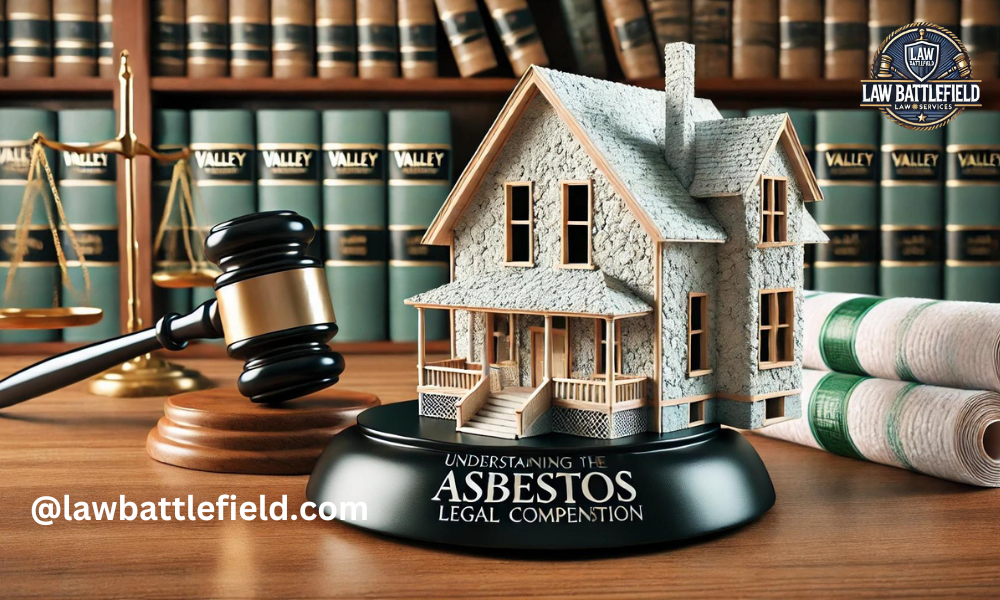Introduction To Asbestos And Its Legal Implications
Overview Of Asbestos: Its History And Usage In Construction And Manufacturing
Asbestos is a naturally occurring mineral that was once widely used in various industries, especially construction and manufacturing. The material was popular because it is resistant to heat, fire, and electricity, making it useful for insulation, roofing, floor tiles, and cement. From the early 20th century until the 1970s, asbestos was heavily used in buildings, homes, schools, and even automobiles. Its durability and heat resistance made it a staple in many products.
However, over time, the serious health risks of asbestos exposure became well known. Asbestos fibers, when disturbed, become airborne and can be easily inhaled or ingested. Once inside the body, these tiny fibers can cause severe, long-term damage.
Health Risks Associated With Asbestos Exposure (Mesothelioma, Lung Cancer, etc.)
Exposure to asbestos is linked to serious illnesses. The most dangerous diseases include mesothelioma, a rare form of cancer that affects the lining of the lungs and other organs, lung cancer, and asbestosis (a chronic lung disease). What makes asbestos-related diseases particularly hazardous is their long latency period—symptoms often appear decades after exposure. People may not realize they were exposed until they start experiencing breathing issues, chest pain, or other severe symptoms.
Even low levels of asbestos exposure can be dangerous. Those at the highest risk are individuals who worked in construction, shipbuilding, and manufacturing industries, as well as people living or working in old buildings where asbestos was used in the materials.
Importance Of Addressing Asbestos Exposure Legally
Given the severe health impacts of asbestos, it’s crucial to address exposure legally. Many people were unknowingly exposed to asbestos at work or in their homes, and companies responsible for using the material often failed to provide proper warnings or protection. This is where legal action becomes essential.
If you or a loved one has been exposed to asbestos, you may be entitled to compensation. Lawsuits and claims can help cover medical bills, lost wages, and other damages caused by asbestos-related diseases. Asbestos-related legal questions often involve understanding who is responsible for the exposure—whether it’s a property owner, employer, or manufacturer. Pursuing a legal claim ensures that responsible parties are held accountable and that victims receive justice.
Understanding The Valley Asbestos Legal Question
Definition Of “Valley Asbestos Legal Question” In Relation To Regions Such As Sacramento, Apple Valley, And Scotts Valley
The term “Valley Asbestos Legal Question” refers to legal issues surrounding asbestos exposure in specific regions, including Sacramento, Apple Valley, and Scotts Valley. These areas, like many others across the United States, have a history of asbestos use in various industries and buildings. Asbestos was commonly found in insulation, roofing materials, floor tiles, and other construction products. Because of this, many homes, schools, and commercial properties built before the 1980s in these regions may still contain asbestos.
The legal aspect of this issue arises when individuals in these areas are exposed to asbestos, often unknowingly, and later suffer from related illnesses such as mesothelioma, lung cancer, or asbestosis. The “Valley Asbestos Legal Question” typically involves determining responsibility for the exposure, whether it’s a property owner, employer, or manufacturer. It also covers the legal steps victims need to take to receive compensation for medical expenses, pain, and suffering caused by asbestos-related diseases.
The Commonality Of Asbestos Use In The Area And Its Potential Health Impacts
In regions like Sacramento, Apple Valley, and Scotts Valley, asbestos was a common material used in buildings, particularly during the mid-20th century. Because asbestos is fire-resistant and durable, it was seen as an ideal building material. This widespread use has created long-term risks for residents, construction workers, and others who come into contact with older buildings during renovations or demolitions.
For many in these valley areas, the risks of asbestos exposure were not well known until years after they had been exposed. Today, there are still homes, schools, and commercial buildings in these regions that may contain asbestos, posing an ongoing health threat. When asbestos materials are disturbed, such as during construction work, tiny fibers are released into the air. If inhaled, these fibers can lodge in the lungs and cause serious health issues over time.
The health impacts of asbestos exposure are severe, with mesothelioma being one of the deadliest asbestos-related diseases. Due to the long latency period of these illnesses, symptoms often do not appear until decades after the initial exposure, making it difficult for victims to trace the exact source of their asbestos contact. This complexity adds to the legal challenges in resolving asbestos-related claims, emphasizing the need for specialized legal advice.
The Long Latency Period Of Asbestos-Related Diseases
Asbestos-related diseases such as mesothelioma, lung cancer, and asbestosis have a long latency period, meaning symptoms may not appear for 20 to 50 years after exposure. This extended time frame makes it difficult for many victims to realize that they have been exposed to asbestos until their condition has significantly progressed. For example, someone exposed to asbestos in the 1970s may only develop symptoms today.
Common Diseases: Mesothelioma, Lung Cancer, And Asbestosis
Mesothelioma is the most notorious disease caused by asbestos exposure, primarily affecting the lining of the lungs (pleura) and other organs. It is considered rare but highly aggressive, and it is almost exclusively linked to asbestos. Lung cancer is another serious condition linked to asbestos exposure, though it can also be caused by other factors like smoking. Asbestosis is a non-cancerous lung disease caused by inhaling asbestos fibers, leading to severe respiratory issues and scarring of the lung tissue.
Impact Of Delayed Diagnosis On Legal Cases
The delayed diagnosis of asbestos-related diseases presents significant challenges in legal cases. Victims often struggle to pinpoint the exact moment or location of exposure because it may have happened decades earlier. As a result, proving the direct connection between asbestos exposure and the illness requires thorough documentation, including employment history and medical records. This delay can also affect the ability to file claims within the statute of limitations, which varies by state. Therefore, timely legal action is critical once a diagnosis is made.
Steps To Take After Asbestos Exposure
Immediate Medical Attention And Documenting Exposure
If you suspect asbestos exposure, seeking immediate medical attention is crucial. Early medical intervention can help monitor your health and potentially catch asbestos-related diseases early. Documenting your exposure is equally important. This means keeping track of where and when the exposure occurred, including the type of work you were doing or the building you were in. Medical records, including tests and doctor’s notes, can play a key role in legal cases.
Importance Of Gathering Evidence (Medical Records, Employment History, etc.)
To build a strong legal case, gathering evidence is essential. This includes your employment history, especially if you worked in industries like construction, shipbuilding, or manufacturing where asbestos use was common. Additionally, building inspection reports and any documentation related to the presence of asbestos in your work or living environment will be valuable. Detailed medical records showing your diagnosis and treatment history are also vital to proving your claim in court.
Legal Consultations And The Role Of Specialized Asbestos Attorneys
Asbestos legal cases can be highly complex, involving multiple parties and long timelines. Consulting with an experienced asbestos attorney is a critical step in the legal process. These lawyers specialize in asbestos litigation and are familiar with the nuances of building strong cases. They can help identify responsible parties—such as former employers, product manufacturers, or property owners—and guide you through the process of filing a claim. Asbestos attorneys can also navigate the statutes of limitations and ensure that your case is filed in a timely manner.
Legal Options For Asbestos Victims In Valley Regions
Overview Of Personal Injury Claims, Workers’ Compensation, And Wrongful Death Lawsuits
Asbestos victims in valley regions such as Sacramento, Apple Valley, and Scotts Valley have several legal options for seeking compensation. One of the most common routes is filing a personal injury claim. This type of lawsuit allows individuals who have been diagnosed with asbestos-related diseases like mesothelioma or lung cancer to hold the responsible parties accountable. Typically, these claims are filed against employers, manufacturers, or property owners who exposed individuals to asbestos without proper safety measures.
Workers’ compensation is another option, especially for individuals who were exposed to asbestos at work. Workers’ compensation claims provide benefits for medical expenses and lost wages but typically offer less compensation compared to personal injury lawsuits. This path is suitable when direct lawsuits against an employer may not be possible due to state laws protecting companies from being sued by employees.
Wrongful death lawsuits can also be filed by the families of individuals who have died from asbestos-related diseases. These lawsuits seek to recover damages for the pain and suffering endured by the deceased, as well as funeral expenses, loss of income, and other costs associated with the death.
How To File A Lawsuit Against Employers, Manufacturers, Or Building Owners
Filing a lawsuit for asbestos exposure requires detailed preparation. The first step is gathering evidence that links the exposure to the responsible party, such as employers, manufacturers of asbestos-containing products, or building owners. Once the evidence is gathered, an attorney specializing in asbestos cases will help file a formal complaint in court. This complaint outlines the specific details of the exposure, the health impact, and the compensation being sought.
During the legal process, your attorney will negotiate with the defendants, and in many cases, settlements are reached before going to trial. If a settlement is not reached, the case may proceed to trial, where a judge or jury will determine the outcome.
Differences Between State And Federal Asbestos Laws Governing These Claims
Asbestos-related legal claims are governed by a combination of state and federal laws. Federal regulations, such as those set by the Environmental Protection Agency (EPA) and the Occupational Safety and Health Administration (OSHA), set standards for asbestos handling and worker protection. These federal laws provide a framework, but states have their own specific regulations and statutes regarding asbestos claims.
For example, California’s laws may differ from Texas or Florida in terms of filing deadlines and evidence requirements. Understanding these differences is crucial, as they can significantly impact the success of a claim. A knowledgeable asbestos attorney will navigate these complexities and ensure the case adheres to both state and federal laws.
Statutes Of Limitations And Legal Challenges
Time Limits For Filing Asbestos-Related Claims In Different States
One of the most important aspects of filing an asbestos-related claim is understanding the statute of limitations. This is the time limit in which a claim must be filed after an asbestos-related diagnosis or death. In states like California, the statute of limitations for personal injury claims related to asbestos is typically one year from the date of diagnosis. Texas has a similar two-year statute of limitations, but it can vary depending on the specifics of each case.
These time limits are critical because if a claim is not filed within this period, the victim may lose the right to pursue compensation. States may also have different statutes for wrongful death claims compared to personal injury claims, further complicating the process.
Legal Hurdles: Proving Exposure, Causation, And The Role Of Medical Expert Testimonies
Proving that asbestos exposure directly caused an illness can be a major legal challenge. Because diseases like mesothelioma and lung cancer have long latency periods, victims often find it difficult to trace the exact moment and source of their exposure. For example, someone may have been exposed decades ago at multiple job sites or through environmental factors.
To strengthen a case, medical expert testimonies are often required. These experts can review medical records, employment history, and other evidence to link the disease to asbestos exposure. Additionally, the role of industrial hygiene experts may be necessary to confirm how asbestos exposure likely occurred, especially in complex cases where exposure spans several years or locations.
High-Risk Areas For Asbestos Exposure In Valley Regions
Identification Of High-Risk Buildings (e.g., Homes, Schools, Industrial Sites Built Before the 1980s)
In valley regions such as Sacramento, Apple Valley, and Scotts Valley, many buildings constructed before the 1980s are considered high-risk for containing asbestos. These include residential homes, schools, commercial buildings, and industrial sites where asbestos was used extensively for insulation, roofing, and floor tiles. Because asbestos was highly regarded for its fire-resistant and insulating properties, it was widely used in these structures.
Older schools and public buildings, in particular, may still contain asbestos in materials such as ceiling tiles, insulation, or pipe coverings. Industrial sites, especially those involved in construction, manufacturing, and shipbuilding, are also prime locations where asbestos might have been used. People working in these environments or those renovating older buildings are at a higher risk of exposure, especially if the asbestos-containing materials are disturbed, releasing dangerous fibers into the air.
Importance Of Asbestos Inspections During Renovations Or Demolitions
When it comes to renovations or demolitions of older buildings in these regions, asbestos inspections are crucial. Disturbing asbestos-containing materials without proper precautions can release harmful fibers into the air, endangering not only workers but also residents in nearby areas. Professional inspections are important to identify the presence of asbestos before any construction work begins.
If asbestos is found, specialized removal (or abatement) procedures must be followed to ensure safety. Proper handling and removal of asbestos can prevent the spread of fibers and reduce the risk of serious health problems, such as mesothelioma and lung cancer, for construction workers, residents, and the surrounding community.
Asbestos Trust Funds And Compensation
Explanation Of Asbestos Trust Funds For Bankrupt Companies
Asbestos trust funds were established by companies that produced or used asbestos and have since filed for bankruptcy due to overwhelming claims from victims. These companies, while bankrupt, are still required to contribute to these trust funds to provide compensation for individuals who have been harmed by asbestos exposure. The trust funds allow victims to seek compensation even if the company responsible for their exposure no longer exists or cannot be sued directly.
Trust funds offer a streamlined way for victims to file claims and receive financial compensation for their medical expenses, lost wages, and pain and suffering. The process for filing with a trust fund often involves less legal complexity than going to court, and claimants can still pursue compensation from other liable parties outside the trust.
Potential Compensation: Medical Costs, Lost Wages, Pain And Suffering
Victims who file claims through asbestos trust funds or lawsuits can seek compensation for a variety of damages. This typically includes medical costs associated with treating asbestos-related diseases such as mesothelioma, lung cancer, or asbestosis. In addition to covering treatment expenses, victims may also be compensated for lost wages due to the inability to work, and for the physical and emotional pain they have endured as a result of their illness.
In some cases, compensation can also include punitive damages, especially if it can be proven that the responsible party acted with negligence or knowingly exposed workers or residents to asbestos.
Settlements Vs. Going To Court: What To Expect In Each Case
Many asbestos-related cases are resolved through settlements rather than going to trial. Settlements offer a faster resolution and are often less stressful for victims, allowing them to avoid the lengthy court process. In a settlement, the responsible party agrees to pay a certain amount of compensation to the victim without admitting liability. Settlement amounts can vary depending on the strength of the case, the severity of the illness, and the evidence provided.
On the other hand, if a settlement cannot be reached or the offered amount is not satisfactory, the case may go to trial. Going to court can result in a higher payout, but it comes with risks, including a longer timeline and the possibility of losing the case. A skilled asbestos attorney can help victims decide the best approach based on their specific situation and the evidence available.
Recent Legal Cases And Trends In Asbestos Litigation
Impact Of Recent Asbestos Legal Cases On Local And National Rulings
Recent asbestos-related legal cases have set important precedents at both local and national levels. These cases often focus on issues such as liability, compensation amounts, and the burden of proof required for establishing a direct link between asbestos exposure and diseases like mesothelioma or lung cancer. In some recent rulings, courts have reinforced the responsibilities of companies to protect their employees and the public from asbestos exposure, even decades after the materials were used.
At the national level, certain cases have clarified how asbestos trust funds are to be distributed, ensuring fair compensation for victims. These rulings have influenced ongoing and future claims, as they provide a framework for how courts should approach similar lawsuits. The outcome of these cases also encourages companies to settle before trial, pushing them to offer fair compensation to avoid costly court battles.
How Court Decisions Influence Future Asbestos-Related Lawsuits
Court decisions in asbestos cases continue to shape the future of asbestos litigation. When courts rule in favor of plaintiffs, it strengthens future claims by setting precedents that future cases can reference. For instance, rulings that confirm the link between specific asbestos products and certain diseases make it easier for victims to file claims against manufacturers. Additionally, courts may dictate stricter safety regulations for companies handling asbestos, influencing how asbestos removal and abatement projects are conducted moving forward.
These legal precedents also affect settlement negotiations. Companies aware of prior rulings may choose to settle out of court to avoid the risk of losing at trial, which benefits victims by providing quicker compensation.
How To Choose The Right Asbestos Lawyer
What To Look For In An Experienced Asbestos Attorney
Choosing the right lawyer is crucial when pursuing an asbestos-related case. A good asbestos attorney should have extensive experience handling similar claims, particularly in complex asbestos litigation. They should also have a proven track record of success, including both settlements and trial victories. An attorney with in-depth knowledge of both state and federal asbestos laws will be able to navigate the legal landscape effectively.
In addition, it’s important to find a lawyer who can provide access to medical and occupational experts. These experts are critical in proving the connection between asbestos exposure and the resulting health conditions. The right lawyer should also be compassionate and understand the emotional and financial toll that asbestos-related diseases take on victims and their families.
The Role Of Lawyers In Gathering Evidence, Handling Trust Fund Claims, And Navigating The Legal Process
Asbestos cases require thorough evidence gathering, including medical records, employment history, and other documentation that links the victim’s illness to asbestos exposure. An experienced asbestos lawyer will take charge of this process, ensuring that no critical evidence is missed.
Additionally, many asbestos claims are filed against companies that have gone bankrupt. In such cases, asbestos trust funds are available to compensate victims. A lawyer familiar with these trust funds can help victims file claims and navigate the paperwork efficiently. Beyond handling trust fund claims, an experienced attorney will manage the entire legal process, including negotiations with insurance companies, representing clients in court, and ensuring that claims are filed within the statute of limitations.
Preventive Measures And Public Health Concerns
Local Regulations On Asbestos Handling And Removal
Local governments and health departments have specific regulations in place to manage the handling and removal of asbestos. These rules are designed to minimize the risk of exposure to workers and the public during construction, demolition, and renovation projects. For example, contractors in valley regions must follow strict procedures for asbestos inspection before starting any work on older buildings.
These regulations often require that only licensed professionals handle asbestos removal, ensuring that the asbestos fibers are properly contained and disposed of. Failure to follow these guidelines can result in significant legal penalties and endanger the health of the community.
Community Education On Asbestos Risks And Legal Rights
Community education plays a crucial role in preventing asbestos exposure. Many people are unaware that older homes and buildings may contain asbestos, which could be disturbed during renovations or natural disasters. Public health initiatives that educate people about the dangers of asbestos, as well as their legal rights if exposed, are essential for reducing future health risks.
Communities can benefit from workshops, informational campaigns, and outreach programs that inform residents about how to identify asbestos, when to call a professional for inspections, and how to seek legal help if they believe they have been exposed.
Conclusion
In conclusion, the “Valley Asbestos Legal Question” involves significant health risks, complex legal procedures, and the potential for substantial compensation. For those affected by asbestos exposure in the valley regions, legal recourse is crucial. Victims should seek specialized legal advice promptly to navigate the challenges of filing claims, gathering evidence, and securing compensation from trust funds or settlements. Addressing asbestos exposure legally helps protect victims’ rights, ensures justice is served, and holds companies accountable for negligence.
Frequently Asked Questions (FAQs)
What Are The Health Risks Of Asbestos Exposure?
Asbestos exposure can lead to serious health issues such as mesothelioma, lung cancer, and asbestosis. These diseases often take 20 to 50 years to develop after the initial exposure.
How Do I Know If My Building Contains Asbestos?
Buildings constructed before the 1980s are more likely to contain asbestos in insulation, flooring, or roofing materials. You should hire a certified asbestos inspector to confirm its presence before renovation or demolition work.
What Should I Do If I’ve Been Exposed To Asbestos?
Seek immediate medical attention and document your exposure. It is also important to consult a specialized asbestos attorney to understand your legal options and possibly file a claim for compensation.
How Can I File A Claim For Asbestos-Related Diseases?
You can file a personal injury lawsuit, workers’ compensation claim, or a wrongful death lawsuit if a family member has passed away due to asbestos exposure. Consult an experienced asbestos attorney to guide you through the process.
What Compensation Can I Receive For Asbestos Exposure?
Compensation may include medical expenses, lost wages, pain and suffering, and sometimes punitive damages. Victims may also claim from asbestos trust funds if the responsible company is bankrupt.
Is There A Time Limit For Filing An Asbestos Lawsuit?
Yes, statutes of limitations vary by state but typically range from one to three years after diagnosis or death. It’s important to consult a lawyer as soon as possible to ensure your case is filed on time.
Was this article helpful? Check out more on Lawbattlefield.com
Independence Mesothelioma Legal Question: Exploring Your Legal Rights And Options





